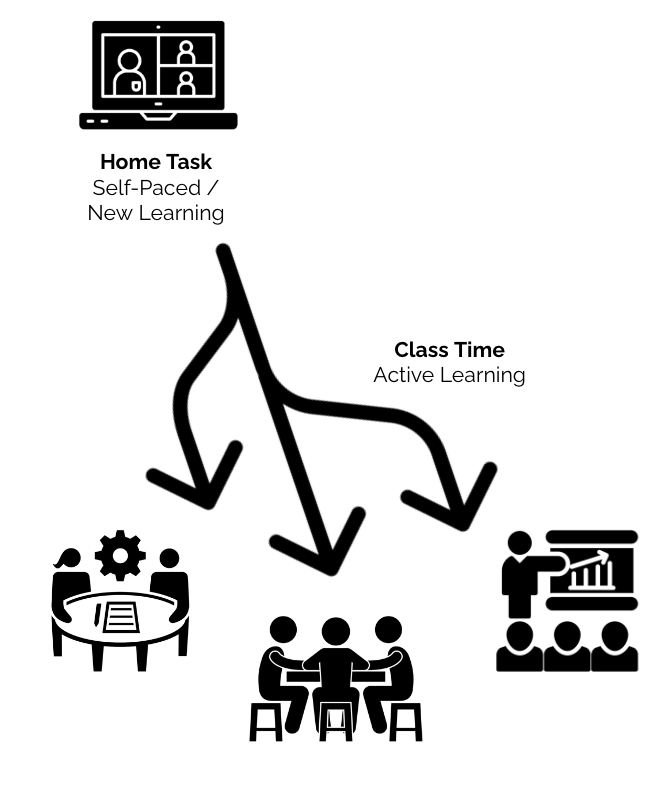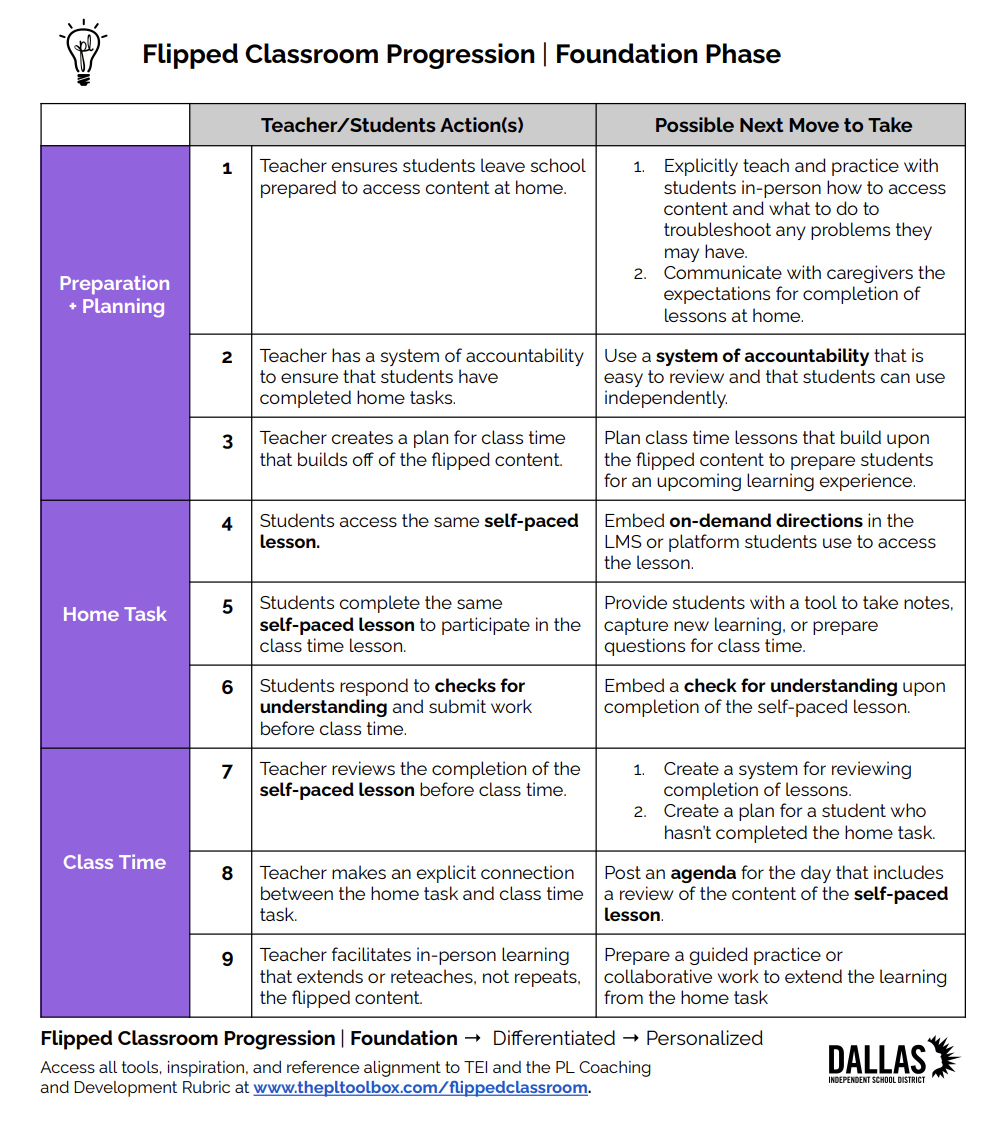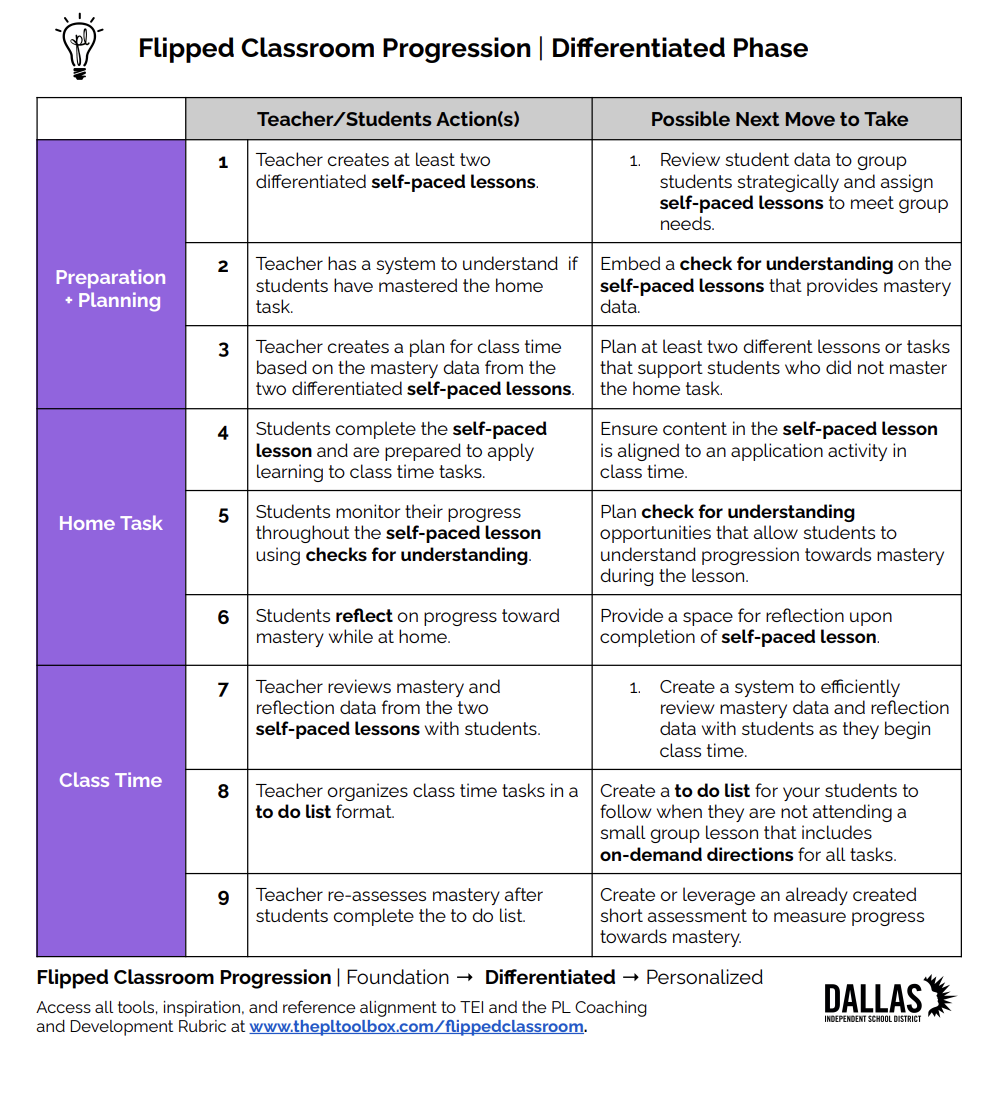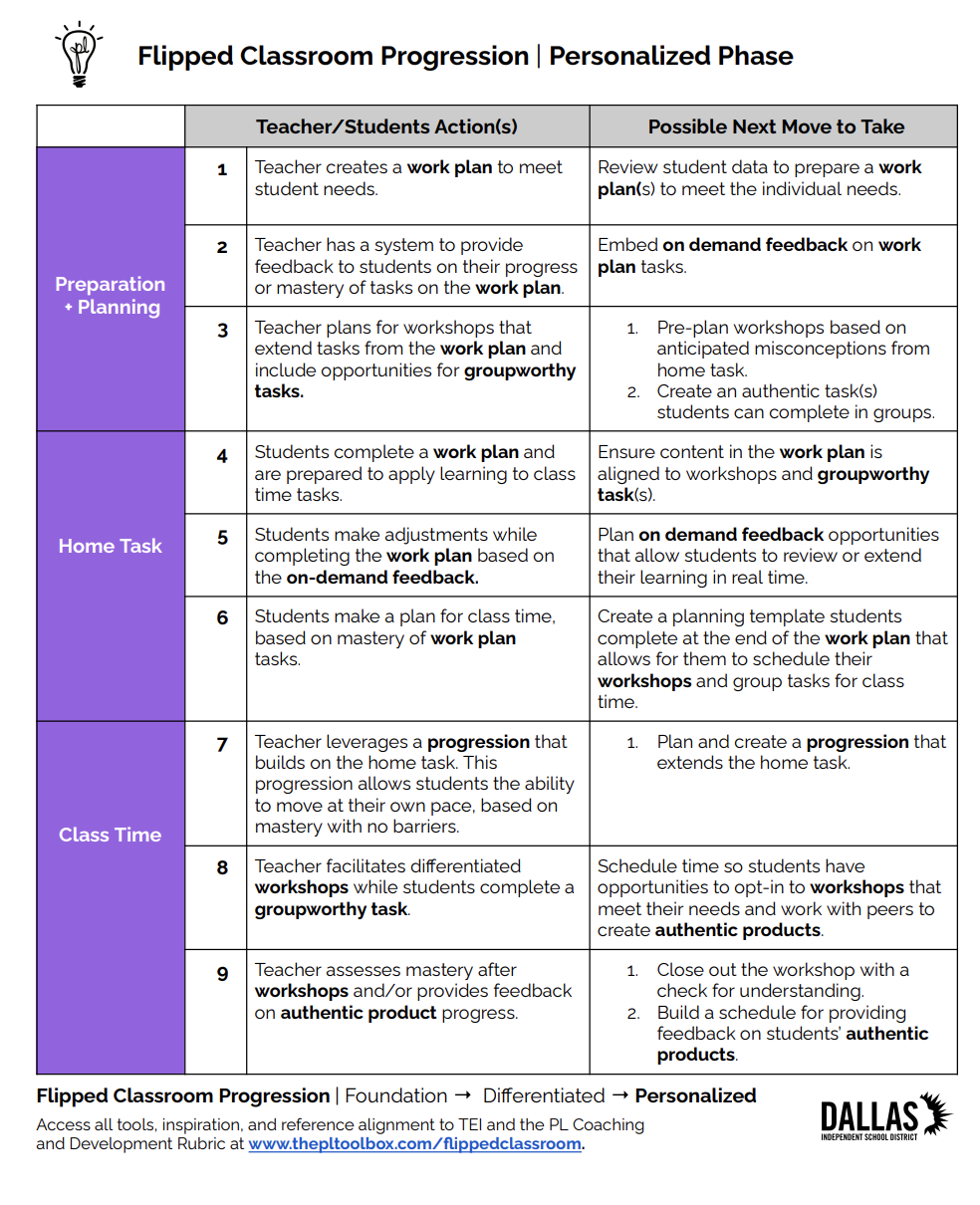The Flipped Classroom Progression is a tool that identifies the necessary steps to take when implementing a Blended Flipped Classroom Model
|
Flipped Classroom Model
Learn more about the Flipped Classroom Model by visiting the Blended Learning Universe at www.blendedlearning.org. |
|
|
A progression is a pathway a learner might take to reach the end goal or learning target. This tool is carefully sequenced across three phases of implementation:
|
|
Identifies the sequence of teacher and student actions that must be mastered in order to establish the foundation and readiness for an effective flipped classroom.
|
Identifies the sequence of teacher and student actions that enables differentiation in an effective flipped classroom.
|
Builds on the Foundation and Differentiated phases to identify the sequence of teacher and student actions that meet the need and interest of every learner.
|
Foundation Phase
Identifies the sequence of teacher and student actions that must be mastered in order to establish the foundation and readiness for an effective flipped classroom.
Preparation and Planning
1. Teacher ensures students leave school prepared to access content at home. Routines and Procedures, Access to Materials |
Next Move: 1. Explicitly teach and practice with students in-person how to access content and what to do to troubleshoot any problems they may have. 2. Communicate with caregivers the expectations for completion of lessons at home. |
|
2. Teacher has a system of accountability to ensure that students have completed home tasks. Routines and Procedures |
Next Move: Use a system of accountability that is easy to review and that students can use independently. |
|
3. Teacher creates a plan for class time that builds off of the flipped content. Varied Learning Experiences |
Next Move: Plan class time lessons that build upon the flipped content to prepare students for an upcoming learning experience. |
|
Home Task
Next Move: Embed on-demand directions in the LMS or platform students use to access the lesson |
|
5. Students complete the same self-paced lesson to participate in the class time lesson. Self-Direction, Routines and Procedures |
Next Move: Provide students with a tool to take notes, capture new learning, or prepare questions for class time. |
|
6. Students respond to checks for understanding and submit work before class time. Student Feedback |
Next Move: Embed a check for understanding upon completion of the self-paced lesson. |
Class Time
Next Move: 1. Create a system for reviewing completion of lessons. 2. Create a plan for a student who hasn’t completed the home task. |
|
8. Teacher makes an explicit connection between the home task and class time task. Routines and Procedures, Differentiated Learning Objectives |
Next Move: Post an agenda for the day that includes a review of the content of the self-paced lesson. |
|
9. Teacher facilitates in-person learning that extends or reteaches, not repeats, the flipped content. Varied Learning Experiences |
Next Move: Prepare a guided practice or collaborative work to extend the learning from the home task |
|
Differentiated Phase
Identifies the sequence of teacher and student actions that enables differentiation in an effective flipped classroom.
Preparation and Planning
Next Move: Review student data to group students strategically and assign self-paced lessons to meet group needs. |
|
2. Teacher has a system to understand if students have mastered the home task. Student Feedback, Data Driven Instruction |
Next Move: Embed a check for understanding on the self-paced lessons that provides mastery data. |
|
3. Teacher creates a plan for class time based on the mastery data from the two differentiated self-paced lessons. Data Driven Instruction |
Next Move: Plan at least two different lessons or tasks that support students who did not master the home task. |
Home Task
4. Students complete the self-paced lesson and are prepared to apply learning to class time tasks. Self-Direction |
Next Move: Ensure content in the self-paced lesson is aligned to an application activity in class time. |
|
5. Students monitor their progress throughout the self-paced lesson using checks for understanding Self-Direction, Peer Accountability |
Next Move: Plan check for understanding opportunities that allow students to understand progression towards mastery during the lesson. |
|
6. Students reflect on progress toward mastery while at home. Self-Direction, Opportunities for Input |
Next Move: Provide a space for reflection upon completion of the self-paced lesson. |
|
Class Time
7. Teacher reviews mastery and reflection data from the two self-paced lessons with students. Data Driven Instruction |
Next Move: Create a system to efficiently review mastery data and reflection data with students as they begin class time |
|
8. Teacher organizes class time tasks in a to do list format. Self-Direction |
Next Move: Create a to do list for your students to follow when they are not attending a small group lesson that includes on-demand directions for all tasks. |
|
Next Move: Create or leverage an already created short assessment to measure progress towards mastery. |
|
Personalized Phase
Identifies the sequence of teacher and student actions that enables personalization in an effective flipped classroom.
Preparation and Planning
|
Next Move: Review student data to prepare a work plan(s) to meet the individual needs. |
|
2. Teacher has a system to provide feedback to students on their progress or mastery of tasks on the work plan. Student Feedback |
Next Move: Embed on demand feedback on work plan tasks. |
3. Teacher plans for workshops that extend tasks from the work plan and include opportunities for group worthy tasks. Authentic Assessment, Data Driven Instruction |
Next Move: 1. Pre-plan workshops based on anticipated misconceptions from home task 2. Create an authentic task(s) students can complete in groups |
|
Home Task
4. Students complete a work plan and are prepared to apply learning to class time tasks. Personalized Learning Pathways |
Next Move: Ensure content in the work plan is aligned to workshops and groupworthy task(s). |
|
5. Students make adjustments while completing the work plan based on the on-demand feedback. Opportunities for Input |
Next Move: Plan on demand feedback opportunities that allow students to review or extend their learning in real time. |
|
6. Students make a plan for class time, based on mastery of work plan tasks. Opportunities for Input, Mastery Based Progression |
Next Move: Create a planning template students complete at the end of the work plan that allows for them to schedule their workshops and group tasks for class time. |
Class Time
7. Teacher leverages a progression that builds on the home task. This progression allows students the ability to move at their own pace, based on mastery with no barriers. Mastery Based Progression, Data Driven Instruction |
Next Move: Teach students how to review their own data and make purposeful decisions about what to practice or which task to complete. |
|
8. Teacher facilitates differentiated workshops while students complete a groupworthy task. Mastery Based Progression |
Next Move: Schedule time so students have opportunities to opt-in to workshops that meet their needs and work with peers to create authentic products. |
|
9. Teacher assesses mastery after workshops and/or provides feedback on authentic product progress. Student Feedback |
Next Move: 1. Close out the workshop with a check for understanding. 2. Build a schedule for providing feedback on students’ authentic products. |
|
| Flipped Classroom Extended Progression | |
| File Size: | 166 kb |
| File Type: | |
| Flipped Classroom Progresion | Foundation Phase | |
| File Size: | 160 kb |
| File Type: | |
| Flipped Classroom Progression | Differentiated Phase | |
| File Size: | 159 kb |
| File Type: | |
| Flipped Classroom Progression | Personalized Phase | |
| File Size: | 161 kb |
| File Type: | |






